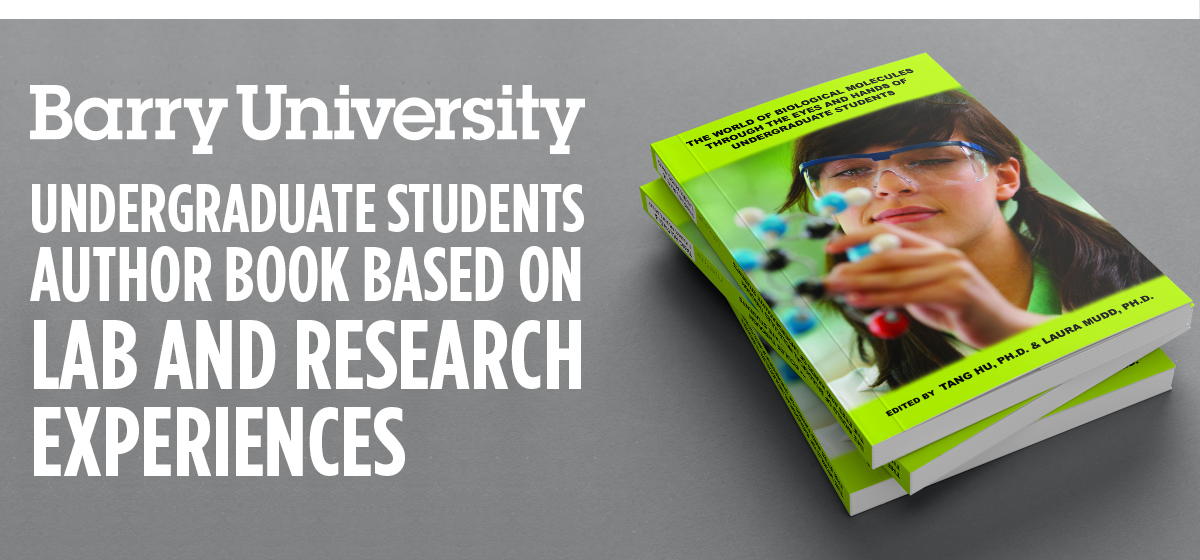What’s a good way to reflect upon memorable experiences? Write about them. That’s exactly what a group of 15 undergraduate students from Barry’s College of Arts and Sciences recently did as it pertained to their research and hands-on experience in a cell biology lab course.
The students — biology and chemistry majors — took the time to each write an essay or story based on the biological research experiments they learned. The result is a 78-page book titled, “The World of Biological Molecules Through the Eyes and Hands of Undergraduate Students.” The book, published in late 2015 by Green Ivy Publishing, was edited by Drs. Tang Hu, professor, and Laura Mudd, professor and chair of the Department of Biology.
Students contributing to the book include: Elizabeth Anne Mancuso; Allison Lewis; Mandy Carper; Trenisha Ashley Smith; Heather Silverstein; Jarred Fiedler; Karrie Garcia; Victoria Hoelscher; Iliana Palenzuela; Marlena Britton; Tayler Malinowski; Shashana Fiedler; Daria Vasilyeva; Brittni J. Bent; and Peter Nwokoye.
“The stories and essays in the book provide unique insight into understanding our students and their education, life and the course of growing up,” said Hu. “The writing itself derives students to search to understand the complexity of biological molecules. Meanwhile, the interactions with student authors during the writing process motivated the instructors’ teaching and research.”
The essays and stories, written in non-scientific language, center on cells — the smallest unit of life that consist of many molecules — and how the interactions among these molecules are necessary for our daily life, so much in fact that any disorder in these events could cause severe diseases including cancer. The book reflects the students’ view on the world of biological molecules, and provides a picture on education and the campus life of these students.
The book and its essays/stories centers around the following lab activities:
- Cytology of mammalian cells and differentiation induction of cancer cells: These lab activities introduce students to basic cytology of normal (fibroblasts, epithelial cells, macrophage, and lymphocytes) and cancer cells (HL-60 leukemia cells) by preparing and staining slides and observing the morphology of these cells under a light microscope. Students also study the functions of each type of cells and understand the molecular mechanisms responsible for cell differentiation and cancer formation.
- Protein exclusion by size chromatography: The aim of this lab activity is to teach students chromatography techniques and how to separate and purify proteins from other molecules.
- Dot-Immunobinding Assay (Dot Blot Assay): Dot-blot assay is a technique used to detect the presence of an antigen, a similar process to enzyme-linked immunosorbent assay (ELISA). This assay is based on the absorption of proteins onto a nitrocellulose membrane.
- Determination of unknown protein molecular sizes: In this experiment, students study basic chemical properties and major functions of proteins.
- Study of enzyme kinetics: The purpose of this lab activity is to help students to develop a better understanding of basic chemical characteristics and Michaelis-Menten kinetics of an enzyme.
- Restriction Enzyme Digestion: This experiment introduces students to important concepts of restriction enzyme digestion, genetic engineering and DNA mapping. Students examine the digestion pattern of DNA, analyze the migration distances, and determine the size of unknown DNA fragments.
- Cloning, transformation, and expression of recombinant LacZ gene: The main objectives of this lab activity are to study important concepts of DNA replication, transcription and translation, and learn recombinant DNA technology. By performing this experiment, students will develop a deeper understanding of gene expression.
- Determination of gene mutation and genotype of Drosophila: In this experiment, DNA is extracted from one "wild type" and one “white” fly using extraction buffer, which involves several steps, including the break-down of the cell membrane, precipitation of DNA, and separation of DNA from the rest of the cell debris by centrifugation.

